
In this issue:
• Review of critical levels and loads
• Trends Report - Habitats are now considered more sensitive to N
• Air Pollution Recovery Indicators (APRI) Project
• News from around the UK
Number 11 – Winter 2023
Air Pollution Bulletin
Air pollution is a major environmental pressure that is felt at a range of scales from local to regional and global. Air pollutants can affect biodiversity and ecosystem services, harm human health and contribute to climate change. Since the last bulletin published in early 2019, global understanding about air pollution and its effects on people and nature has continued to grow.
JNCC and the country nature conservation bodies (CNCBs) collaborate on air pollution work through the Interagency Air Pollution Group (IAPG). Through the group, we work together to provide evidence and advice on air pollution impacts on biodiversity and ecosystems.
The Air Pollution Bulletin provides an overview of the IAPG’s key activities, in what has been a busy and exciting period for the group. There are also links to further information. It is principally an update for policy leads and conservation agency staff, but we hope it is also of interest to other organisations, the research community and the general public. If you have any comments, or would like more details on any of the topics covered, please email Susan.Zappala@jncc.gov.uk
A lot has changed since the last bulletin with IAPG joint working on several UK level projects to enhance understanding of air quality issues and inform national and UK-level policy going forward. These have come to fruition thanks to partnerships forged with Defra and the governments of the four countries to work at UK level. Many have focussed on traditional subjects such as ecosystem and air quality monitoring, however several projects also looked at how this evidence is used in approaches to risk assessment and decisionmaking.
JNCC’s coordination and international influence have played a key role in facilitating the IAPG’s work and ensuring that UK evidence gathering and capability are fit for purpose. As multi-lateral environmental agreements look to refresh ambitions around pollution, including from air pollution, JNCC’s experts are working with the four countries to leverage UK expertise and evidence at a global level through enhanced joint working in the UK.
This issue takes a themed approach to reflect the UK level working alongside the country-specific pursuits. We hope you enjoy this issue of the IAPG Air Pollution Bulletin and look forward to hearing how the evidence can help in your work. To learn more please sign up to the JNCC Air Pollution Project Stakeholder list.
Cover image: Lichen © Rachael Howlett
2
Introduction
Welcome to the latest Air Pollution Bulletin from the JNCC led UK Air Pollution Interagency Group.
In our latest publication we will get an update on the growing public awareness of air pollution impacts on human health and nature in the UK. We will set out the latest Defra air pollution trends results which shows that while traditional pollutants such as nitrogen dioxide and sulphur dioxide continue to reduce the emissions of ammonia in places such as Wales (as detailed in the most recent UK National Atmospheric Emissions Inventory, page 31) and its impacts on biodiversity continue to increase.
The benchmarks for air pollution assessment critical loads (deposition) and critical levels (atmospheric concentrations) have recently been peer reviewed across Europe and updated in the UK. These changes have been integrated into the 2023 update of the UK Air Pollution Information System which provides a comprehensive resource of air pollution impacts on biodiversity and is the assessment tool used across the UK to support planning and regulation of air pollution.
A tour around the country agencies will provide a snapshot of progress on a number of issues; from multi agency support in updating air pollution modelling tools and broadscale Countrywide Nitrogen Budgets, through to work on air pollution monitoring and developments to better evaluate sources of agricultural ammonia emissions including measures to address them at a farm level. The Bulletin also details the results of new research to assess the impacts of air pollution on essential pollinators such as bees.
This edition will conclude with an update on multi agency collaborative engagement to develop a new UK air pollution assessment tool as well as a proposal to update the lichen app that is invaluable to our agencies and a wider audience.
The development of regional agricultural support schemes post EU exit offers us a unique opportunity to address the issue of increasing ammonia emissions and the increasing damage they are causing in the UK. Not only can lowering ammonia emissions directly benefit local biodiversity, it also reduces the overall impact on the environment and human health enabling recovery.
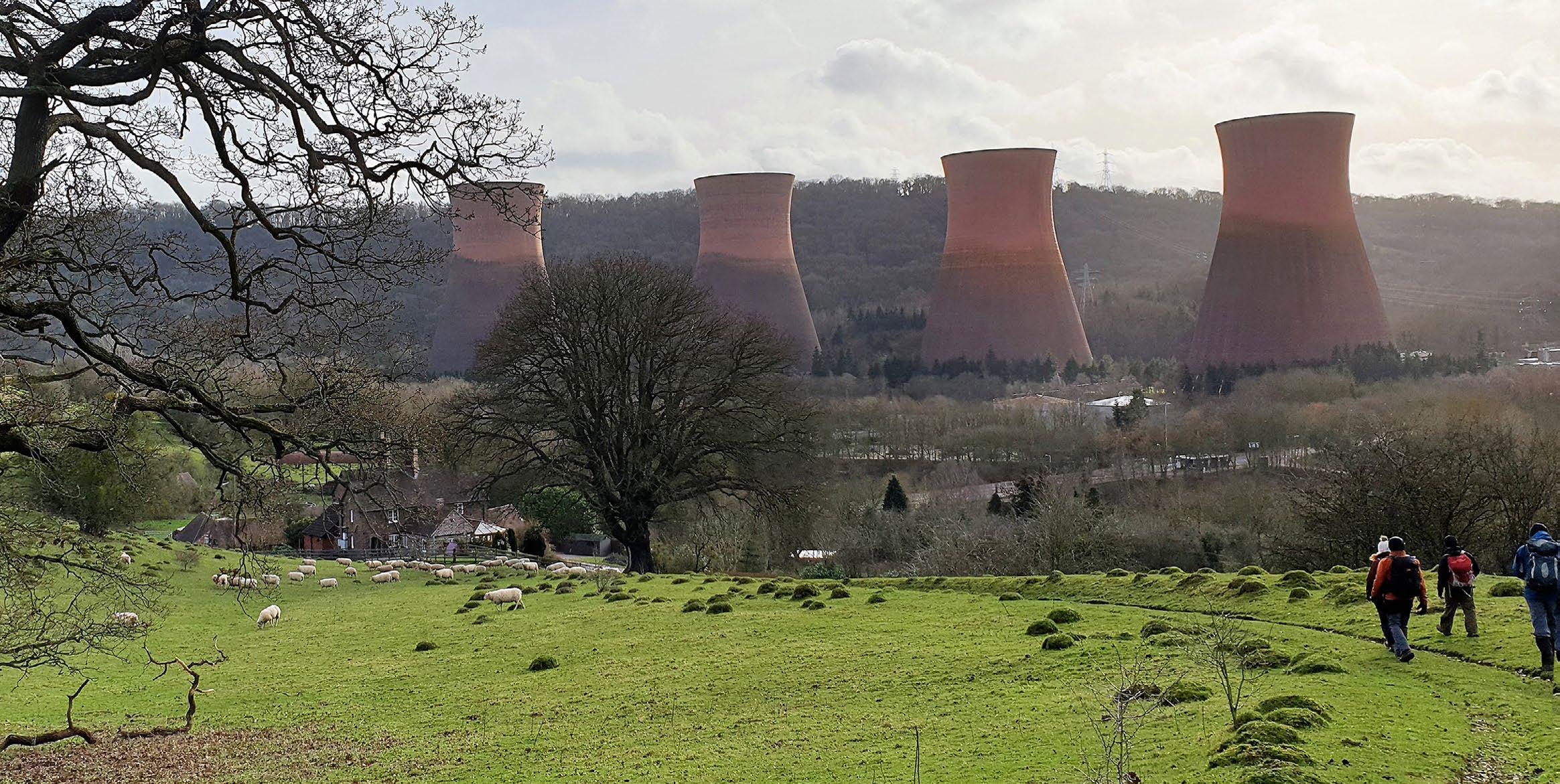
3
Simon Bareham – Chair of the Inter-agency Air Pollution Group (IAPG)
Clean Air for Nature
Air pollution can affect human health, cause declines in biodiversity as well as exacerbating climate change. However, getting real change relies on public support. Defra has partnered with Global Action Plan (along with other organisations such as Scottish Government, Welsh Government, Opinium and Mitsubishi electric) to run an annual Clean Air Day campaign in June, to raise public awareness and action on air pollution. JNCC have been proud supporters of Clean Air Day since 2021.
In June 2023, JNCC posted on social media to raise awareness about the impacts of air pollution on nature. Types of posts included sharing an air pollution calculator where individuals could calculate their contribution to air pollution; detailing ideas of what people can do to reduce contributions to air pollution; and explaining how lichens are indicators of air pollution and encouraging individuals to take a walk and identify them.
JNCC included four questions about air pollution and nature in the annual Clean Air Public Insight Tracker (CAPIT) survey in late June, after Clean Air Day. The key results from the survey can be seen in the infographic below.
JNCC have included the same four questions post Clean Air Day in 2021, 2022 and 2023 in the CAPIT where 2000 adults were asked questions related to air pollution, human health, and nature to gauge public awareness, attitudes, and behaviour changes. It was found that:
• There were similar responses across the UK 4 countries.
• Concern over the impacts of air pollution on nature has increased over time: 2023 (62%), 2022 (57%), and 2021 (44%).
• Public knowledge that air pollution affects nature as well has human health has increased over time: 2023 (61%), 2022 (50%), and 2021 (46%).
• About 1 in 3 people know that lichens are indicators of air pollution. Go to OPAL surveys by Imperial College London to find out about how lichens benefit nature and people, how to find and identify them.
• Importance placed on reducing air pollution because it impacts nature as well as human health has stayed high (75-80%) between 2021-23.
• Knowledge that air pollution affects nature is consistent across age groups. Knowledge increased in 55+ year olds from 41% in 2022 to 59% in 2023. This could tie in with recent messaging of being a ‘good ancestor’ for nature and leaving a legacy for future generations.
JNCC is involved in air pollution projects with all four countries of the UK. This work includes the Air Pollution Assessment Service (APAS), Nitrogen Futures, Nitrogen Futures 2 and 3, and the Air Pollution Recovery Indicators (APRI) project. The Inter Agency Air Pollution Group plays an important role in joining up the country nature conservation bodies, aiding collaborative work and knowledge sharing between agencies.
For more information about Clean Air Day please visit our webpage and use the contact form for any questions.
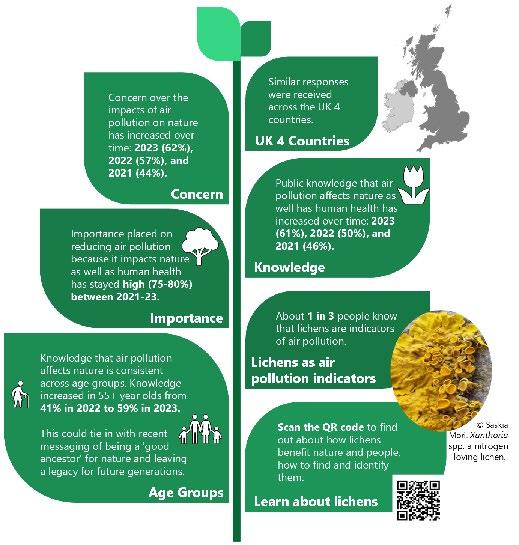
4
Habitats are now considered more sensitive to N, affecting exceedance statistics
The annual Air Pollution Trends Report has been published and is available on the UK-AIR website. A major change this year is that new values have been applied for the critical load for nutrient nitrogen (N). This is the best estimate of the minimum amount of N deposition that will cause harm to a habitat. New evidence has shown effects at lower rates than were previously thought harmful, so lower values have been applied for most habitats, resulting in increases in exceedance statistics. It is now clear that over 99% of the area of nitrogen-sensitive habitat in England, Wales and Northern Ireland is receiving a damaging load of atmospheric N every year. Even in Scotland, which is relatively unpolluted, the critical load for N is exceeded across 76% of these habitats.
The report shows the exceedance of critical loads for N and for acidity, and exceedance of critical levels for ammonia, over the period 2003-2020. The same methods were applied throughout, including the new critical load values, so that trends in pollution pressure over time can be assessed clearly. There have been declines over this period in sulphur pollution and oxidised nitrogen, but ammonia pollution has increased. For example, the area of the UK where sensitive bryophytes and lichens are exposed to harmful concentrations of ammonia has increased from 57% to 64% since 2003. Due to the decrease in oxidised N emissions, total nitrogen deposition (oxidised and reduced) onto sensitive protected habitats in England has decreased by 9% since 2016. This is an encouraging sign that the Clean Air Strategy target of a 17% decline between 2016 and 2030 can be met, if emissions continue to decrease.
The Air Pollution Trends Report is available on the UK AIR website

5
Excess Acidity (Average Accumulated Exceedance of acidity critical load) and b) Excess Nitrogen (Average Accumulated Exceedance of nutrient-nitrogen critical load) in 2020. Although the legends for the two maps are given in different units, the class intervals are the same (e.g. 7 kg N ha1 year-1 is equal to 0.5 keq ha-1 year-1).
News in Brief
Review and revision of nitrogen critical loads 2022
The empirical critical loads for nitrogen were last reviewed in an expert workshop held in Noordwijkerhoot, The Netherlands, 2010. The proceedings were published in 2011 (see Bobbink and Hettelingh, 2011). Under the UNECE Convention on Long Range transboundary Air Pollution (CLRTAP) an expert workshop was held in Berne, Switzerland during October 2021. The meeting was organised by the Swiss Federal Office for the Environment (BAFU), the Coordination Centre for Effects (CCE) and the B-WARE Research Centre.
New relevant information from studies since the 2011 revision to summer 2021 on the impacts of nitrogen on natural and semi-natural habitats was reviewed. For the first time gradient studies were included in the review of evidence to evaluate and determine the nitrogen critical loads. The outcomes of this report are of importance for the protection of nitrogen sensitive natural and semi natural ecosystems and for supporting policies to reduce air pollution.
Review and revision of empirical critical loads of nitrogen for Europe (2022). R Bobbink, C Loran and H Tomassen (editors). https://www.umweltbundesamt.de/en/publikationen/review-revision-of-empirical-critical-loads-of
https://www.umweltbundesamt.de/en/publications
Review of the ammonia critical levels 2023
The Convention of Long Range Transboundary Air Pollution (CLRTAP) ammonia critical levels were last reviewed and updated in 2009. Under the International Co-operative Programme for Modelling and Mapping (ICP MM), the Federal Environment Agency, Germany (Umweltbendesamt, UBA) hosted an expert workshop held in their headquarters in Dessau-Roßlau. Evidence on the effects of ammonia on vegetation and ecosystems from research and monitoring were presented and discussed. In total over 100 delegates were present both in-person and online. Nineteen presentations from representatives from nine countries provided evidence of ammonia monitoring networks in their respective countries, the effects on vegetation and ecosystems, and a review of models and future trends across Europe. The Report includes a thematic literature review and summaries of the presentations given. The proceedings dealt with new concepts and techniques for the determination/monitoring of ammonia as well as effects-based approaches for the assessment of adverse environmental impacts. The proceedings provide an important source of information for policy makers. The recommendations were agreed upon and forwarded to the CLRTAP and the on-going European wide stakeholder consultations during the revision of the Ambient Air Quality Directives. The proceeding can be found at the following link,
Review of internationally proposed critical levels for ammonia (2023). Proceedings of an Expert Workshop held in Dessau and online 28/29 March 2022. Prepared by J Franzaring and J Kösler, Institute of Landscape and Plant Ecology, University of Hohenheim, Stuttgart. On behalf of the German Environment Agency
https://www.umweltbundesamt.de/en/publikationen/review-of-internationally-proposed-critical-levels
https://www.umweltbundesamt.de/en/publications
6
Air Pollution Information System (APIS) updated with more data and a new screening tool
The Air Pollution Information System (APIS), launched 19 years ago in 2004, provides information on air pollution and its effects on habitats and species. Developed in partnership by the UK conservation agencies, regulatory agencies and the UK Centre for Ecology and Hydrology (UKCEH), it went through a major update in 2021, with the release of its mapping tool
APIS went again through several major updates since. The mapping tool now accounts for both UK and Ireland, as it displays pollutant deposition and concentration data coming from the models CBED (Concentration Based Estimate of Deposition) and PCM (Pollution Climate Mapping), and EMEP for Ireland. It covers background concentrations of ammonia and nitrogen for several covers, as well as concentrations of NO x and SO2. Information on sites for 5 designations across both countries (SAC, SPA, SSSI/ ASSI, NHA, ancient woodland) is now available. APIS database has also been updated several times, to account for:
• new sites and update information on their features,

• to work with a 1km resolution for all years, pollutants and countries (except for source attribution, still at a 5km resolution),
• extended time series (from mid-years 2005-2019 to mid-years 2003-2020 for UK, and 2018 for Ireland),
• a Screening Acidity Critical Loads tab has also been added, with suggested critical loads and background concentrations for nitrogen and sulphur.
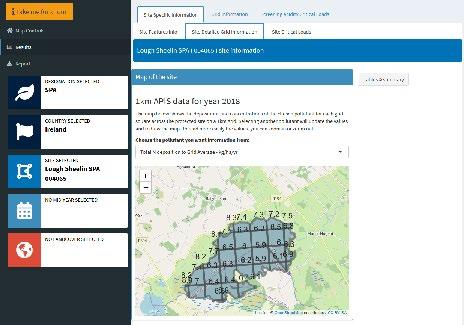
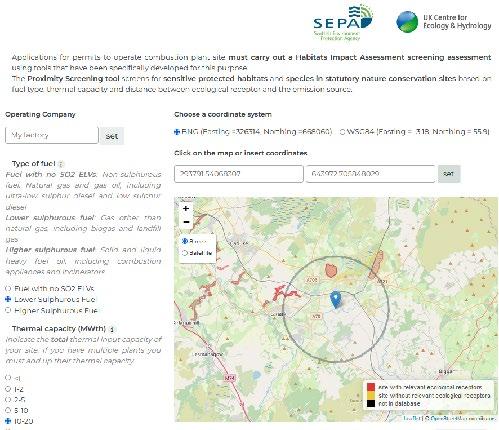
To help the users navigate through these updates, several user workshops have been organized, one of which will be held in the next few months for Irish agencies.
The mapping tool goes through continuous maintenance and upgrades, as around £60k will be invested in 2024 to extend the time series to mid-year 2021 for UK and year 2020 for Ireland, as well as provide new Lichen app for mobiles. Furthermore, if funding can be secured, Source Attribution modelling will be carried out using latest emissions year for both countries (2020 for UK and Ireland).Alongside with these updates, APIS welcomed in 2023 a new tool: the MCP screening tool; designed in partnership by UKCEH and SEPA to list protected sites and features around potential new combustion plants.
7
Welcome map with SACs for both countries
The Site Detailed Grid Information tab for a site with a 1km resolution
MCP tool
Air pollution news from Scotland
Cleaner Air for Scotland 2 Delivery
Scottish Government has published the second annual progress report for delivery of the Cleaner Air for Scotland 2 Strategy. The strategy is a cross cutting document which aims to improve air quality across a range of policy areas including transport, planning and agriculture. The update to the National Planning Framework (NPF4) gave direct consideration to air pollution and air quality issues from agriculture which have been addressed in revisions to the Prevention of Environmental Pollution from Agricultural (PEPFAA) code. Chapter one on Slurry and Manure is complete, with a new General Binding Rules on Silage and Slurry. A chapter on fertilisers is currently being written. Revision of legislation on muirburn to manage heather moorland is underway. If implemented the Bill will require land managers to obtain a licence to undertake muirburn at any time of the year
Nitrogen Balance Sheet
In December 2021 Scottish Government published a baseline nitrogen balance sheet, which tracks the flows of nitrogen across the economy and environment. Improved nitrogen management will result in better air quality, water quality, nature and biodiversity outcomes as well as contributing to tackling climate change.
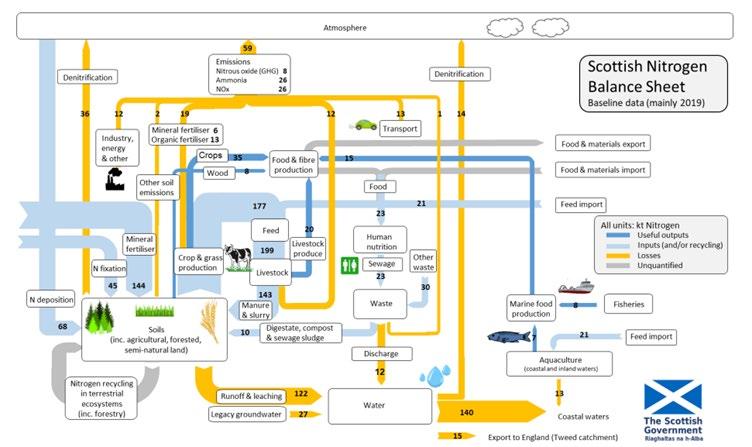
(Reproduced from Establishing a Scottish Nitrogen Balance Sheet 5, with permission from Scottish Government) Nitrogen flows for Scotland (kt N / yr), combining data across all sectors of the economy and environment from latest available data (majority of data are from 2019, but with some from 2010-2020). N.B. Values may not add up due to rounding. Some minor flows (< 1kt N / yr) are not shown.
Total emissions of nitrogen to air in Scotland amount to around 59 ktN/yr. Most of the nitrogen in the form of ammonia (NH3) is deposited in Scotland, whereas nitrogen oxides (NOX) from transport and industry is mostly exported. In turn Scotland receives NH3 and NO x as air pollution from Europe and Ireland and are a net importer of nitrogen. The underpinning report for this section shows how decreases in NH3 emissions from the Scottish agricultural sector between 2012 and 2018 have been partially offset by imports from outside the country
The potent greenhouse gas nitrous oxide (N2O), arising largely from agriculture and land use change, represents 8% of Scotland’s greenhouse gas emissions (2019 figures). The two other main greenhouse gases, CO2 and methane, respectively represent 70% and 19% of the total.
8
Wetlands and water bodies play an important role in converting reactive nitrogen into inert di-nitrogen (N2). The process is very complex, but the value is roughly estimated to be in the region of 50 ktN/yr
Publication of the balance sheet is regulated under Scottish Statutory Instrument 2002 No.87 The Climate Change (Nitrogen Balance Sheet) (Scotland) Regulations 2022 as a provision under the Climate Change (Scotland) Act 2009.
Research into the Impacts of Air Pollution in Scotland
As part of the 2022-2027 RESAS Strategic Programme scientists at the James Hutton Institute are implementing a programme of work to improve understanding of the impacts of nitrogen deposition on Scottish natural ecosystems in the context of a changing climate, providing evidence on how natural ecosystems are changing, what is driving this change and how best to manage and protect them.
Two fascinating reports are now available:
• Nitrogen and Climate: A review of the interactive effects of nitrogen deposition and climate change on Scottish semi-natural ecosystems
• Nitrogen Mitigation: A review of the nitrogen deposition impacts and mitigation potential in Scottish semi-natural ecosystems.
Full details and project updates as they become available can be seen at: www.hutton.ac.uk/NINE
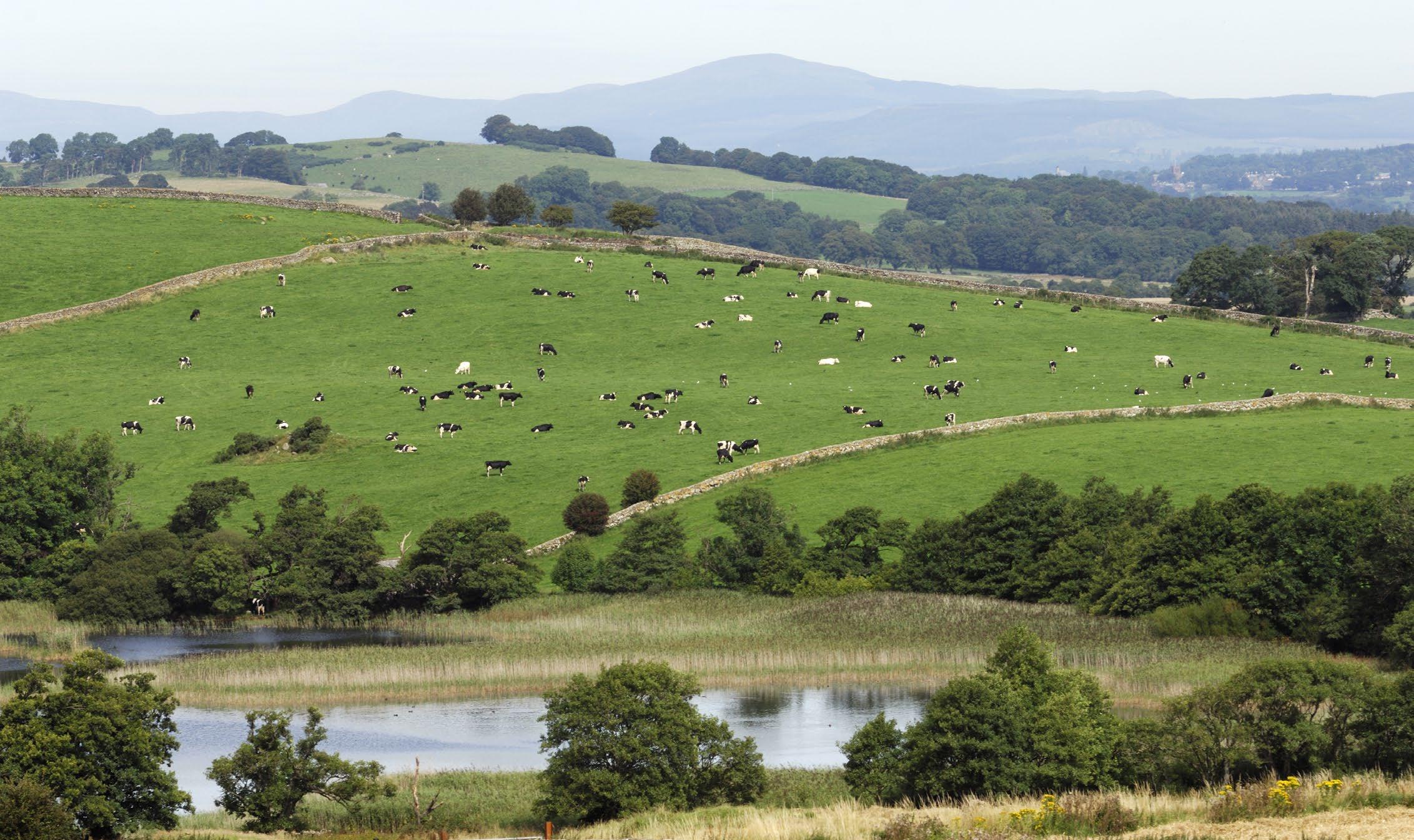
9
Freshwater loch and agricultural landscape, Dumfries and Galloway Area © Lorne Gill/NatureScot
Air pollution news from Northern Ireland
Vegetation analysis and biomonitoring at nitrogen sensitive habitats across NI
Atmospheric nitrogen deposition represents a threat to naturally nutrient-poor plant communities, leading to a potential loss of conservation value for many statutory nature conservation sites. Under domestic and international legislation, a duty is placed on countries to protect, conserve, and restore protected areas to favourable condition, as well as to enhance wider biodiversity. The assessment of risk to these habitats focuses on a critical level and load approach. The use of biomonitoring for nitrogen (N) complements the assessment of critical level and load exceedance in that it considers current biological responses at sites.
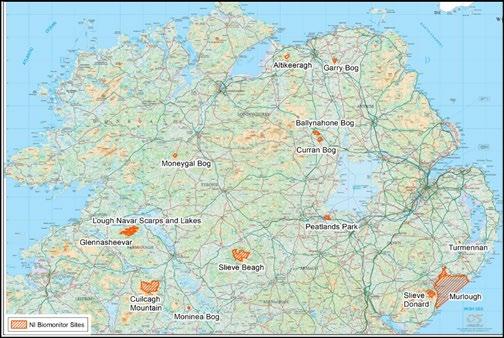
In collaboration with the UK Centre for Ecology & Hydrology (UKCEH) and project partners; Ulster Wildlife, the National Trust, Monaghan County Council and Fermanagh & Omagh District Council, DAERA NIEA has undertaken a programme of biomonitoring at protected areas across NI as part of their wider evidence programme to evaluate how these naturally nutrient-poor ecosystems are affected by the addition of excess nitrogen.
Two methods have been used across 14 protected areas in NI: testing N-content (%N) and foliar ammonium levels (NH4-N). Previous biomonitoring research showed that testing foliar ammonium levels can assist with detecting recent changes in ammonia concentrations, because of for example, activities such as landspreading of slurries and manures. The sites have been selected to incorporate a variety of sensitive habitat types with varying NH3 concentrations, including lowland raised bog, fen, upland blanket bog and heath, and sand-dune communities.

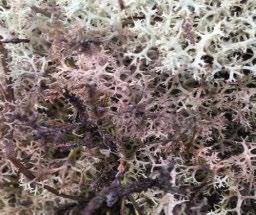
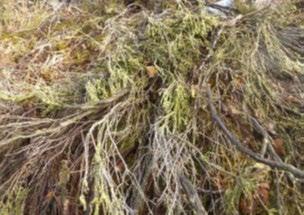
Visible signs of N-related degradation have been recorded at habitats across NI, as shown in the images above. Biomonitoring approaches combined with atmospheric nitrogen monitoring, vegetation analysis and consideration of critical level and load exceedance creates an evidencebased approach to assessing N-related risk to habitats.
The N-content from 4 sites is compared in the graph opposite. The results from Lough Navar ASSI in 2007 are much lower than from the other sites, as is expected from the low ambient ammonia levels (<1.0 µg m-3).
Moninea Bog SAC results show elevated foliar-N levels during the operation of a local farm (2007; gradient >25 (adjacent to farm) to 1.7 µg m-3 NH3 at 850m away) and reduced foliar-N levels after the closure of the farm in 2017. However, the foliar content of the vegetation samples from Cuilcagh Mountain SAC are comparable with the levels found at Ballynahone Bog SAC, where there are much higher NH3 air concentrations

10
Map outlining biomonitoring across NI
Images of degradation taken at lowland raised bogs across NI
Graph showing vegetation N content: foliar ammonium (NH4-N) at 4 sites in NI. Van Dijk et al. (2021) reports to NIEA and Ulster Wildlife
It is suspected that the levels at Cuilcagh may be a result of N deposition. A wet deposition collector has been placed on the site to analyse levels of N in precipitation. Two years of sampling has completed, with results expected by June 2024.
Nitrogen retained in ecosystems could cause a delay in vegetation recovery but standardised biomonitoring approaches provide a mechanism to analyse N-levels through time, facilitating the detection of early degradation or recovery. Reports can be accessed at https://www.daera-ni.gov.uk/articles/effects-air-pollution-natural-ecosystemsscience-and-evidence-publications and on the NERC Open Research Archive.
Atmospheric Nitrogen Impacts on NI’s Semi-Natural Ecosystems: Local Monitoring at SACs
Ammonia emissions and subsequent elevated concentrations of atmospheric ammonia gas (NH3) and nitrogen deposition (originating from both NH3 and NO x emission sources) pose a key threat to the integrity of semi-natural ecosystems, particularly sensitive sites close to emission sources. Over 75% of NI’s land is in agricultural use with sites protected for biodiversity interest located in a predominately agricultural landscape.
In collaboration with UK Centre for Ecology & Hydrology (UKCEH) and project partners; Ulster Wildlife, the National Trust, Monaghan County Council and Fermanagh & Omagh District Council, DAERA NIEA is undertaking a programme of monitoring and evidence work. This work aims to identify and quantify sources of atmospheric nitrogen input to protected areas, to inform mitigation strategies and to evaluate how these naturally nutrient (N)-poor ecosystems are affected by the addition of excess nitrogen.

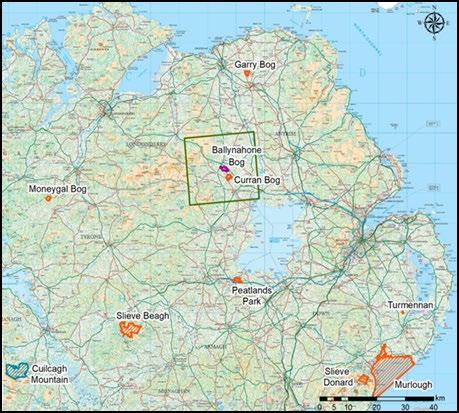
Monthly atmospheric ammonia measurements have been ongoing at ten Special Areas of Conservation (SACs) across Northern Ireland, the first of which started in 2014. The sites have been selected to incorporate a variety of sensitive habitat types, including lowland raised bog, fen, upland blanket bog, heath and sand-dune communities. In addition to monitoring atmospheric ammonia concentrations, a nitrogen oxide monitor and a bulk-rain collector to measure inputs from wet deposition were added to Ballynahone Bog SAC in 2021. The air quality measurements of NH3, NO2 and precipitation chemistry have been used to calculate total N deposition from both wet and dry forms and compare this to modelled estimates (CBED).
Local prevailing wind patterns and meteorology play a key role in atmospheric nitrogen input to semi-natural ecosystems. Automated weather stations have been installed on two SACs to investigate local wind patterns.These data are analysed in conjunction with NH3 measurements.
This site-based information can be used to inform local mitigation plans when assessing suitable measures, such as upgrading livestock housing, using low emission slurry spreading and storage techniques, or planting tree belts at suitable locations, with the aim of preventing further damage from air pollution and ultimately restoring the sites to favourable ecological condition.
Reports can be accessed at https://www.daera-ni.gov.uk/ articles/effects-air-pollution-natural-ecosystems-science-andevidence-publications and on the NERC Open Research Archive.

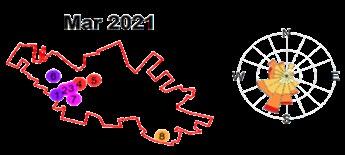

11
Monitoring regime at Ballynahone Bog SAC.Tang et al. (2022), report to DAERA NIEA
Ammonia concentrations and meteorology at NI SAC. Williams et al. (2022), report to DAERA NIEA
Map of SACs with atmospheric nitrogen monitoring across NI
Air pollution news from Wales
Addressing Ammonia Emissions in Wales for Sustainable Farming
In Wales, the pressing concern of ammonia emissions demands immediate action. Unlike other air pollutants, which are decreasing over time, ammonia pollution and its impacts continues to increase in Wales. Ammonia emissions have increased by approximately 17%, in Wales (2010-2021. National Atmospheric Emissions Inventory, NAEI 2023). The area of land impacted in Wales by ammonia pollution has also increased by approximately 18%, over the same period (UK Air Pollution Trends, see article on page 5).
In NRWs latest Corporate Plan a priority to “minimise pollution” has been identified as key to help address the current Nature and Climate Emergency in Wales.
To help deliver this NRW has recently appointed two Sustainable Nitrogen Air Pollution Advisers.
Engaging Farmers for Sustainable Farming Schemes (SFS):
One of the focuses of the New Nitrogen Advisors is to engage farmers in adopting the Sustainable Farming Scheme (SFS) the replacement, in 2025, for the Common Agricultural Policy payments in Wales. The SFS is seen as a key delivery tool to reduce farm-based ammonia impacts. Promoting environmentally friendly practices while safeguarding agricultural productivity. Through discussions and monitoring of ammonia at sites, the team aims to encourage farmers’ buy-in and explore innovative interventions such as new technology applications. It is hoped these approaches can be adopted by WG to support the SFS.
Data-driven Action with UKCEH Profiling App:
The advisers will utilize the new UKCEH Profiling app to conduct a thorough analysis of nitrogen concentrations from various agricultural sectors on selected sites. An example of the analysis is shown below. The data depicts the amount of Ammonia in kilograms per hectare per year, organized into concentric circles radiating from the centre of the SSSI. The circles represent varying distances, such as 0-1km, 0-2km, 0-3km, and so on. Additionally, the data is categorized by agricultural sector for a more detailed breakdown. For further details and access to the system contact brian.price@naturalresourceswales.gov.uk
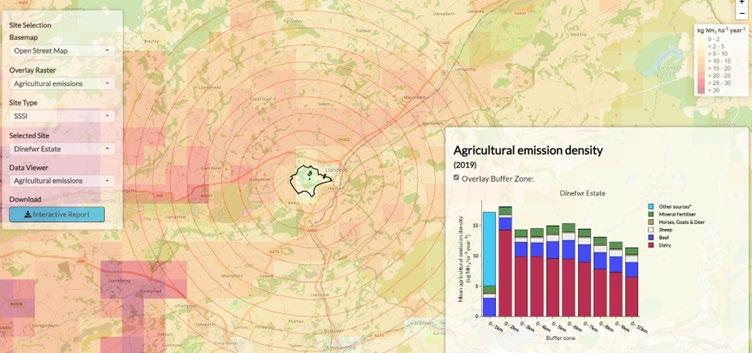
A total of 1080 SSSI throughout Wales have been profiled using this tool. This data-driven approach helps the team to create Site Nitrogen Action Plans (SNAPs); tailored strategies to address ammonia emissions on selected SSSI. Moreover, they will actively contribute to the SNAP DRAGONS (Delivering Regional Action on the Ground On Nature Sites) by working with farmers to reduce impacts on biodiversity. Dinefwr Park SSSI is not only a key site for its rare Lichen assemblage but also plays a crucial role in the implementation of SNAP DRAGONS.
12
Ammonia Emissions density by agricultural sector at Dinefwr Park SSSI
Holistic Approach for Positive Impact:
By utilising SNAPs, SNAP DRAGONS,
and SFS, the New Nitrogen Advisors aim to foster a holistic approach. This approach focuses on addressing the ammonia issue while preserving biodiversity and ecological balance in Wales. Collaborating with farmers, government agencies, and local communities, the team aims to create a positive impact on air quality, sustainable farming practices, and the region’s natural habitats. The two advisors will examine a number of exemplar sites across Wales and provide a range of practical farm-based ammonia reduction measures that can be adopted and rolled out via the SFS.
The New Nitrogen Advisors’ workplan showcases the commitment to reducing ammonia emissions in Wales, ensuring a greener and more sustainable future for agriculture, and maximizing targeted biodiversity benefit. Their work will also help reduce the overall level of ammonia that leads to the formation of fine particle pollution that impacts on human health in accordance with the legal requirements of SMNR (Sustainable Management of Natural Resources) in Wales.
Brian Price and Simon Bareham
SCAIL Combustion Tool for Medium Combustion Plant (MCP)
At the request of the four UK environment agencies (SEPA, EA, NIEA, NRW), coordinated by NRW, the SCAIL tool has been updated by CEH as a suitable screening tool for the assessment of impact on conservation sites for NOx and SO2 from small to medium combustion plant. The tool supports assessments required by the Industrial Emissions Directive (IED) and Medium Combustion Plant Directive (MCPD).
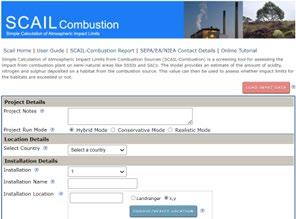
The updated SCAIL Combustion tool employs AERMOD modelling software to model plume dispersion of the combustion emissions. In addition to habitats impact assessment, the updated SCAIL Combustion tool has also introduced the assessment for health impact due to NO2 and SO2 and PM10.
The updated SCAIL Combustion tool has added a Hybrid Mode. While still being “conservative” (worst case scenario), the Hybrid Mode will greatly reduce this over precautionary approach compared to the existing Conservative Mode. The Hybrid Mode will provide more realistic modelled outputs Many new met data sites have also been added to the tool in each country, e.g., the met data sites increased from 4 to 16 in Wales.
Once the user has input the required data, the tool will select the nearest meteorological station to the source, run the model based on the inputs and provide modelling predictions at the nearest conservation site selected.
The tool is available on the CEH website SCAIL – Simple Calculation of Atmospheric Impact Limits (ceh.ac.uk)
Saul White and Ji Ping Shi
13
Air pollution news from England
From Busy Bee to Dizzy Bee: Why Air Pollution matters to Pollinators

Changes to behaviour, learning and memory
In 2022, Natural England hosted two PhD student placements from the ACCE (Adapting to the Challenges of a Changing Environment) Doctoral Training Partnership culminating in two in-depth evidence reviews of the existing and most up to date published research regarding the lethal, sub-lethal and habitat-mediated impacts of air pollutants (concentrations in the air and deposition to the ground) to higher trophic species. This focussed particularly on invertebrates. The reviews identify core evidence gaps and understudied research areas. These reviews will act as a critical first step in influencing wider future conservation policy and have significant impact on NE advise, raising public awareness of air quality as an environmental issue and engagement with NGOs.
Several recent studies have found that air pollution changes invertebrate recognition of biogenic VOCs from plants and flowers. In one study, honeybees exposed to petrol exhaust emissions (primarily NOx) took significantly longer to learn plant VOCs and also forgot them faster than unpolluted onesi. Another recent field study found that ozone and NO x at levels below standards set for the protection of sensitive habitats reduced flower visits by pollinators by 83-90%ii. Air pollution results in it being more difficult for pollinators such as honeybees to recognise, locate and memorise the location of their floral resources which impacts foraging efficiency and consequently pollination. Particulate pollution can also be an issue for pollinators as the fine hairs on their bodies that become electrically charged to attract pollen can also attract other fine particulates, including dust and heavy metalsiii .
Changes to food quality and abundance
Eutrophication (nutrient enrichment) changes the availability of certain plants as a food source as a result of increased competition and shading from nitrogen-loving plants, or if the food plant itself is adapted to low nutrient conditions. For example, the marsh fritillary (Euphydryas aurinia) butterfly relies upon its nitrogen sensitive host plant devil’s-bit scabious (Succisa pratensis) as a food source. In Denmark, fertiliser application and atmospheric nitrogen deposition have caused devils-bit scabious to be outcompeted by faster growing, less sensitive plant species. This decline in host plant abundance has led to the collapse of some marsh fritillary populationsiv. Plant quality is also affected by pollution, which can alter nectar and pollen sugar as well as amino acid concentrations, which also affect insect populations. Studies have shown increases in dead larvae and workers in colonies of bumblebee (Bombus terrestris) visiting plants enriched with excess nitrogen as well as physical damage from consuming abrasive particlesv.
Changes to larval development
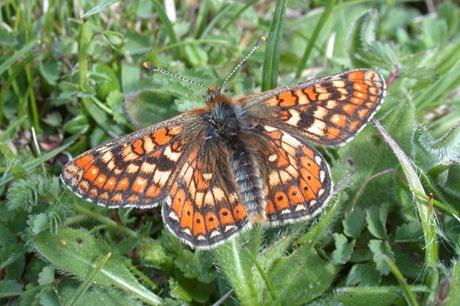
Eutrophication decreases temperatures at the soil surface by increasing plant height and density, preventing the sun’s rays from reaching the soil surface. Several recent studies have shown that this leads to slower growth and development of invertebrate larvae. This can cause misalignment of the timing of larval development and the critical growth stages of their host plant speciesvi. For example, a reduction in numbers and local extinctions of the wall brown butterfly (Lasiommata megera) was caused both by the loss of host plants and by microclimate cooling due to excess nitrogenvii
14
Bumblebee © Natural England/Allan Drewitt
Marsh Fritillary © Natural England/Allan Drewitt
Why does it matter?
Terrestrial invertebrates perform vital functions for numerous ecosystem services, but they are currently experiencing global declines. Pollution is now considered a global threat to invertebrates, and air pollution has received increasing attention as a significant risk factor, especially for pollinators. It has been repeatedly acknowledged across studies, that the impacts of air pollution on invertebrates are understudied. Alteration of plant communities and species composition as a result of a mixture of atmospheric concentrations and subsequent deposition of pollutants have resulted in changes to the behaviour of pollinating species as well as population declines. Pollination is a vital ecosystem service that benefits agricultural and horticultural production and therefore a decline in pollinating species could have devastating implications for food security.
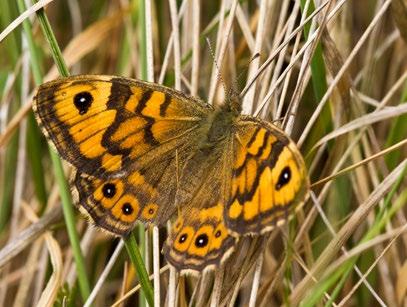
Research has focussed primarily on only a narrow set of indirect impacts (e.g., on habitat or resource loss), or on impacts from a limited number/type of pollutants (e.g., heavy focus on agrochemicals such as pesticides). Comparatively little attention has been paid to more direct effects, with a particular lack of knowledge on the impacts of air quality on invertebrate physiology and behaviour. Specialist species depending on a limited number of food sources are at the greatest risk from impacts of both eutrophication and acidification. Very little research is available regarding the consequences of this for higher trophic species, particularly mammals. Whilst the evidence suggesting impacts to birds and raptors is growing, there is still a significant gap in the research to enable such claims to be made with confidence.
Considering the substantial implications of this emerging research for pollinators and ecosystem services, the impact of air pollution on invertebrates requires further study. Impacts to the environment from air pollution are a universal and transboundary, as well as a local issue but are often overlooked as visible damage is difficult to directly attribute to air pollution. It is essential to recognise that the impact of air pollution will act in-combination with other environmental pressures. Pollution effects are also highly dependent on factors such as temperature and precipitation, therefore adverse effects are also likely to increase under predicted climate changeviii
i R. J. Leonard, V. Vergoz, N. Proschogo, C. McArthur, and D. F. Hochuli, “Petrol exhaust pollution impairs honey bee learning and memory,” Oikos, vol. 128, no. 2, pp. 264–273, Jan. 2019, doi: 10.1111/oik.05405.
ii James M.W. Ryalls, Ben Langford, Neil J. Mullinger, Lisa M. Bromfield, Eiko Nemitz, Christian Pfrang, Robbie D. Girling, Anthropogenic air pollutants reduce insect-mediated pollination services, Environmental Pollution, Volume 297, 2022, 118847, ISSN 0269-7491, https://doi.org/10.1016/j.envpol.2022.118847.
iii G. Capitani, G. Papa, M. Pellecchia, and I. Negri, “Disentangling multiple PM emission sources in the Po Valley (Italy) using honey bees,” Heliyon, vol. 7, no. 2, p. e06194, Feb. 2021, doi: 10.1016/j.heliyon.2021.e06194.
iv Brunbjerg, A. K., Hoye, T. T., Eskildsen, A., Nygaard, B., Damgaard, C. F. & Ejrnaes, R. (2017). The collapse of the marsh fritillary (Euphydryas aurinia) populations associated with declining host plant abundance. Biological Conservation. 211, 117124.
v Ceulemans, T., Hulsmans, E., Ende, W. V. & Honnay, O. (2017). Nutrient enrichment is associated with altered nectar and pollen chemical composition in Succisa pratensis Moench and increased larval mortality of its pollinator Bombus terrestris L. PLoS One. 12, 10.1371/journal.pone.0175160.
vi Nijssen, M. E., WallisDeVries, M. F. & Siepel, H. (2017). Pathways for the effects of increased nitrogen deposition on fauna. Biological Conservation. 212, 423-431.
vii Klop, E., Omon, B. & WallisDeVries, M.F. Impact of nitrogen deposition on larval habitats: the case of the Wall Brown butterfly Lasiommata megera J Insect Conserv 19, 393–402 (2015). https://doi.org/10.1007/s10841-014-9748-z
viii E. L. Zvereva and M. V. Kozlov, “Responses of terrestrial arthropods to air pollution: A meta-analysis,” Environ. Sci. Pollut. Res., vol. 17, no. 2, pp. 297–311, 2010, doi: 10.1007/s11356-009-0138-0.
15
Wall Brown Butterfly © Natural England/Allan Drewitt
UK APAS passes the stage gate 3
Gov assessment; beta is a go!
Are you aware of UK Air Pollution Assessment Service (formerly UK AERIUS) and how it can assist you? UK APAS is an air quality modelling service that will offer a consistent approach to detailed modelling for ecosystem assessment to be used in planning decisions, environmental permitting and local plans. It started as the ‘Integrating Tools for Air Pollution Assessment’ (ITAPA) Project in 2021. See previous Bulletin
This service will facilitate cumulative and “in-combination” assessments across all key emission source types (agriculture, industry, roads) by storing development records in an archive, enabling this critical work to be done consistently and efficiently in the UK for the first time.
The benefits of this service include:
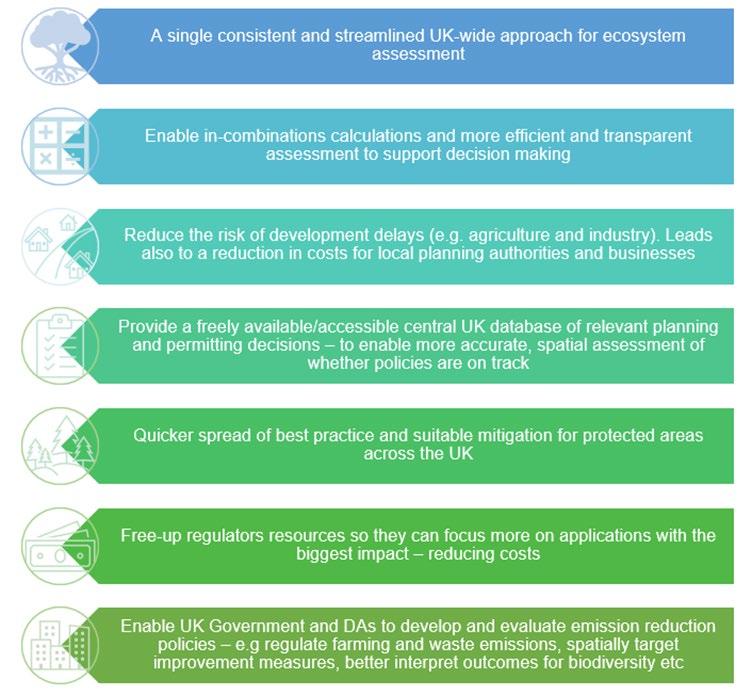
16
User feedback on the tool and the guidance provided has been positive, here is what they have had to say:
Consultant
Regulatory authority Ecologist
Regulatory authority Council
Consultant
“It’s really comprehensive. And includes a lot of options.”
“It’s really great to have that kind of visualisation of where the increases are and how those spreads across the site. Nice little hexagons again.”
Regulatory authority
“I can see it being a really useful tool, its relatively intuitive once you have explored it.”
“It’s good. It gives you a good overview of what’s going on. I think it’s really helpful. It’s simple and to the point but I think that’s appropriate at this stage.”
“I got used to the system quite quickly and was able to enter data and view results. It does a great job at bringing a complex range of information together in a manageable format.’’
The project has now passed stage gate 3 held in October 2023 and has now formally entered the Beta testing phase with new features being introduced such as In-combination Archive, QGIS Plugin and Export Report, quick run feature, in addition to refinement and enhancement to help text and guidance on using the tool and service
This service is expected to be available to government officials, consultants, town planners amongst others in 2024/25. The UK APAS Roadmap provides the key dates and milestones reached.
To keep updated on the project please check out the webpage and/or join the mailing list.
17
Air Pollution Recovery Indicators (APRI) Project

APRI is a Defra funded project that looks at how habitats and species recover from air pollution (Nitrogen).
With the nitrogen deposition levels recorded in the past two decades in the UK this opens fundamental questions related to whethe ecosystems will recover, and how recovery can be assessed. Despite their importance, little is known about how ErM fungi are affected by and recover from nitrogen pollution, and what their contribution to ecosystem recovery looks like.
Phase 1 led by RBG Kew in collaboration with NHM and Imperial College London, explores ecosystem recovery on a dry heathland from a belowground perspective, with a focus on mycorrhizal fungi. Roots of dominant heathland plants, such as the common heather (Calluna vulgaris), form symbiotic associations with ericoid mycorrhizal (ErM) fungi. This association enhances the host plant‘s nitrogen and phosphorous uptake. Nitrogen deposition negatively affects mycorrhizal symbioses and causes nutrient imbalances in the ecosystem.
The initial research will be carried out at Thursley Common National Nature Reserve (NNR) with the establishment of 30 experimental plots. Background nitrogen deposition will be enhanced by adding a nitrogen-based fertiliser in a series of initial pulses. After each fertiliser addition, changes in the ecosystem will be monitored by testing belowground processes (e.g. soil chemistry, fungal community composition, ErM physiology) alongside well-established aboveground indicators (e.g. vegetation physiology, plant chemistry, bryophyte and lichen cover).
The common presence of wildfires and managed burns at the heathland research site also offers the opportunity to investigate the recovery of ErM fungi after fire, and how this recovery might be affected by nitrogen pollution.
There is potential to extend the current research to include further heathland sites in the UK or abroad and to also study the effects of nitrogen pollution on other terrestrial habitats and species.
UKCEH have recently joined the project and will be looking at the recovery of butterflies and/or moths in relation to nitrogen pollution.
A project workshop was held at the Royal Botanical Gardens, Kew on the 7–8 November to scope future work the project could focus on. Workshop participants with a wide range of expertise from Air Pollution to ecosystems looked at join up with other projects such Scotland’s NINE project amongst others. Discussions took place on what recovery looks like, what are good indicators of recovery and what are the next steps for this project. The outputs from the workshop will likely be available in early 2024.
See our project webpage for more information.
To follow this project or participate in future stakeholder events, please sign up to our mailing list.
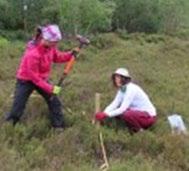
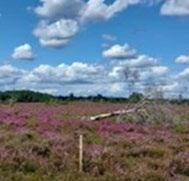
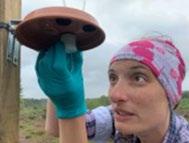
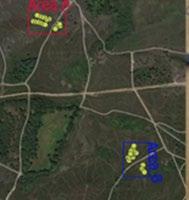
18
Images: Elena Arrigoni and Jill Kowal setting up plots © Jeff Duckett | Heathland © Elena Arrigoni | Elena Arrigoni setting up an ammonia passive sampler (Alpha sampler) © Jeff Duckett | QGIS map of Thursley Common outlining plot locations in area A and B © Jack Wilkinson | Fen Bog Nature Reserve, North Yorkshire Moors © iStock

Lichen app for assessing nitrogen pollution – new developments!
The lichen app is a mobile hybrid app for assessing the status of nitrogen in your area by surveying lichen on trees. By identifying the presence or absence of nine nitrogen sensitive and eight non-sensitive lichens on tree trunks and branches you can get an estimate of how polluted your area is.
The Lichen app has been running on the Air Pollution Information System (APIS) website for over seven years and has recently run into some technical issues as the code becomes out of date for new phones and browsers. From spring 2024 the lichen app will be developed into a full Android and IOs app! Remember while the new app is in development you can always use the lichen tool in the old pencil and clipboard fashion. Full details of the guide can be found at https://www.apis.ac.uk/ nitrogen-lichen-field-manual
Why Nitrogen?
Excess nitrogen can cause eutrophication and acidification effects on semi-natural ecosystems, which in turn can lead to species composition changes and other deleterious effects. Species adapted to low nitrogen (N) availability are at a greater risk from this effect including many slow-growing species, notably lichens and mosses.
Lichens as indicators of nitrogen air quality
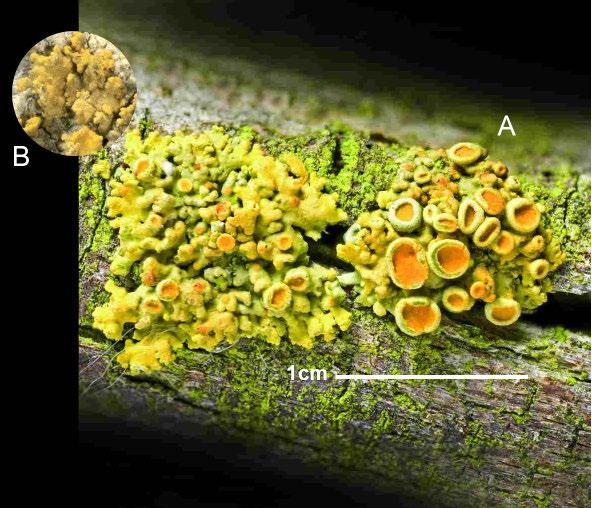
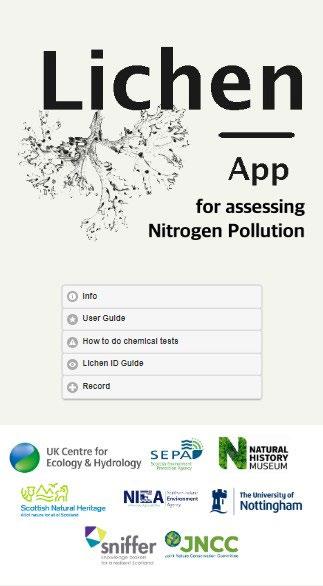
As organisms without roots, lichens obtain their nutrients from the atmosphere and so are highly susceptible to changes in atmospheric chemistry. Research on oak and birch trees across the UK has identified lichens that are sensitive to, or tolerant of, increasing concentrations of nitrogen pollutants in the atmosphere. In the field, the response to increasing atmospheric nitrogen pollution can be measured by the decrease in N-sensitive lichens and the increase in N-tolerant lichens.
Emphasis has been placed on the use of indicator lichens that do not require identification at the microscopic level and that are least likely to be confused with other species. In some cases, all species in a genus are known to be sensitive (e.g. species of Usnea – the beard lichens). In other cases, an individual species within a genus may be an indicator (e.g. Lecidella elaeochroma).
What does the app include and do?
• Includes a simple identification key to epiphytic lichens growing on oak and birch trees that show distinct sensitivity to, or tolerance of, atmospheric N pollution.
• Provides a simple robust method to determine levels of risk to a habitat from gaseous nitrogen pollution by calculating a standardised nitrogen air quality index (NAQI).
• Indicates nitrogen air quality at the location of the trees sampled.

20
Usnea species © Iain Leith
Lichen app home page
Xanthoria polycarpa © Iain Leith
Looking ahead – priority work areas
The IAPG are looking forward to continuing enhanced UK joint working on evidence projects in 2024–2025 and to continue to deliver the research framework. UK and CNCB priorities are aligning as we work together to help restore nature, adapt and mitigate climate change and pursue nature-based solutions to facilitate green recovery
Membership of the IAPG
The IAPG involves specialist staff from the four UK CNCBs and JNCC
JNCC – Susan Zappala and Jack Wilkinson
Natural England – Katharine Blythe and Lydia Hunt
Northern Ireland Environment Agency – Keith Finegan, Hayley McKeown and Áine O’Reilly
Natural Resources Wales – Simon Bareham (Chair), Heather Galliford and Ji Ping Shi
NatureScot – Sue Marrs
Special thanks go to the bulletin designer, Maddy Long.
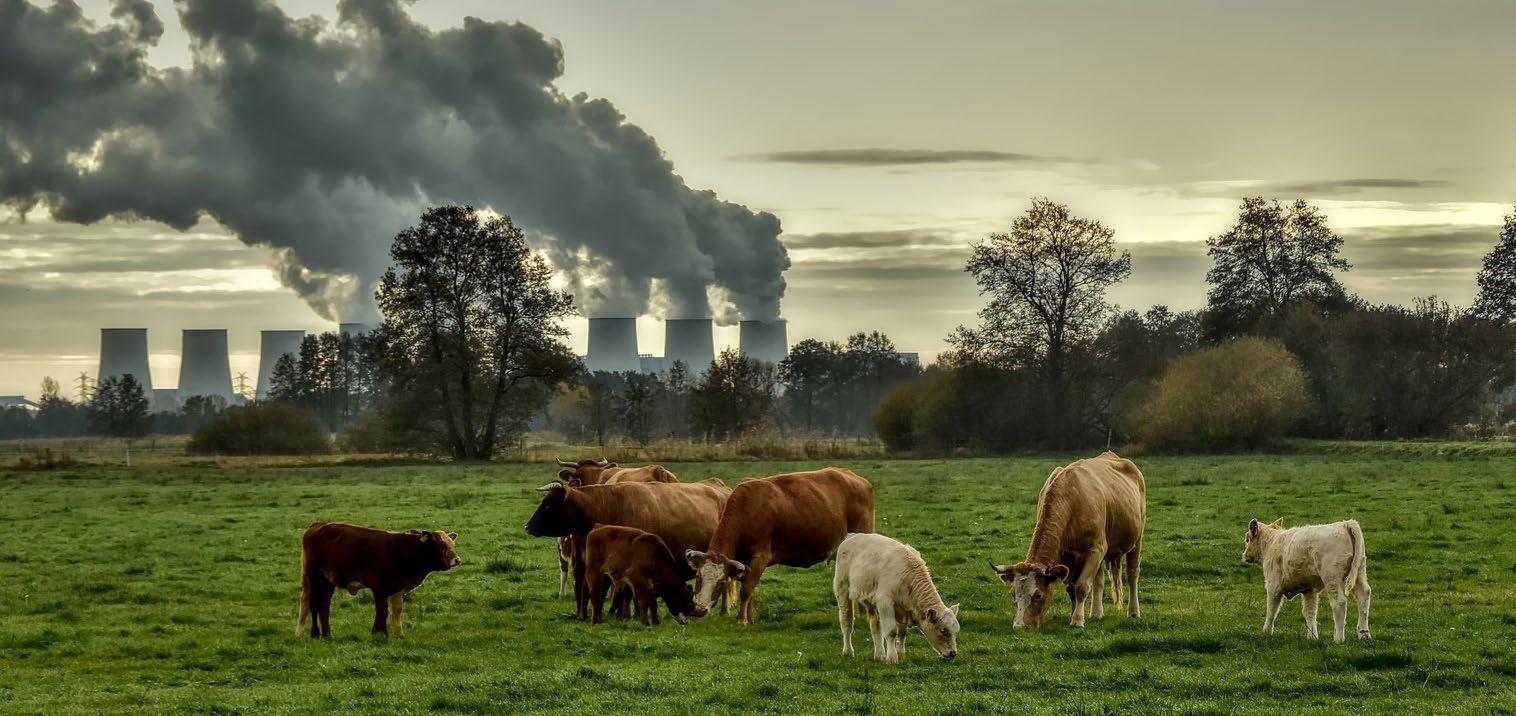
21
©
Peggy Choucaira



































